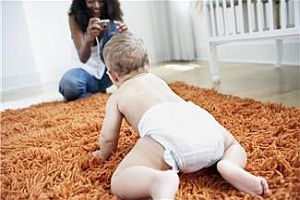There are few surfaces that babies and toddlers touch more often than carpets. After all, they are a warm, soft surface for children to crawl on and provide some cushioning for when they inevitably fall over before learning to walk. However, that same carpeting may be causing more harm than it seems. 
Young children crawling around have a lot of contact with carpeted surfaces and play with toys that often go from carpet to mouth. The chemical toxins that the carpet itself contains, in addition to any household dust it retains, can contribute to a number of health problems in growing children, given their small body size and immature immune systems.
Toxic chemical emissions from new carpet are not a new problem. There have been thousands of cases of people falling ill when new carpeting was installed in their homes, schools or workplaces, and the Consumer Product Safety Commission has tried to discover the reasons for people experiencing irritation of the eyes, nose and throat, fatigue and rashes that new carpeting seemed to cause.
Thus far, no single chemical has been pinpointed as the culprit. However, hundreds of different known toxic chemicals are involved in the production of carpeting. Some of these include benzene (a carcinogen), xylene and toluene (neurotoxins) and styrene (a known carcinogen). They are used in the production of the carpet fibers themselves, the adhesive that glues the fibers to the backing, the dyeing, flameproofing, stainproofing and mothproofing of the carpet, and even in the glue that attaches them to the floor.
Unfortunately, if you thought you might be safe in laying down an old antique carpet that is free of those chemicals, your children still may not be free from the effects of contamination. Researchers have found that common household dust contains traces of lead, combustion byproducts and pesticides in levels that could be considered unsafe for children. In fact, some homes have been found to have more toxic dust indoors than in the outdoor surrounding soil.
Experts advise that there are a few things you can do to keep the amount of toxic dust on your carpets to a minimum:
* By using a high-quality doormat, a 1997 study found that the tracking of pesticides into the home can be reduced by 25%, and the reduction in overall carpet dust by 33%.
* Removing your shoes at the door and wearing house slippers results in 10 times less household dust than in homes where shoes are worn.
* As dust mites thrive in high humidity, the allergies and asthma caused by dust mites that accumulate in carpets can be mitigated by reducing the amount of humidity in your home. Use a dehumidifier in rooms where your children come into frequent contact with the carpet.
* Consider installing plain wood or tile floors where you can use area rugs that can be removed periodically for a thorough cleaning.
* Vacuum weekly with a powerhead vacuum equipped with a dirt sensor and a high-efficiency HEPA filter.
* If you do decide to install a carpet, the best choice is a stitched wool carpet that has not been glued or treated with stain guard. Use carpet staples or hook and loop fastening strips to attach it to the floor in place of glue.
For everyday health tips stop by Chicago Chiropractic
